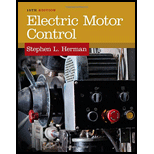
Concept explainers
What is the purpose of inserting resistance in the stator circuit during starting?
Explain the reason of inserting a resistor in a motor stator circuit.
Explanation of Solution
A resistor is inserted in a motor stator circuit in series. The voltage drop caused by inserting resistor reduces the voltage across the motor terminals. Reduced voltage results in reduced starting torque and reduced inrush current. Therefore, the resistor is inserted in stator to reduce the starting voltage of a motor and to avoid the winding damages.
Example:
Refer to Figure 26-1 in the textbook where the supply voltage of 480 V is connected across the resistor and the motor which is connected in series. The resistor voltage drop causes the low voltage
Conclusion:
Thus, the reason for inserting a resistor in a motor stator circuit is explained.
Want to see more full solutions like this?
Chapter 26 Solutions
Electric Motor Control
- A3 ϕ, 15 kV, 60 Hz, 30 MVA, Y-connected cylindrical-rotor synchronous machine generator has Ra =0.5 Ω per phase and Xs =5.2 Ω per phase. The generator delivers the rated load at 15 kV and 0.85 lagging power factor. Determine the excitation voltage, Ef, for this operating condition.arrow_forwardA3 φ, 50 Hz infinite bus bar is connected to two synchronous generators. Generator 1 has a speed of 300 rpm and generator 2 has 30 poles. Determine: the speed of generator 2 the number of poles of generator 1arrow_forward2. Triple Integral Applications 2a. First step Darw the volume of the solids in the first octant which bounded by xy-plane, yz-plane, plane x+y=4 and z. = x2+6. 2b. First draw the region bounded in between z = p and z=1, side by the cylinder r? ≤ 4, and in the first and second octant. Defermine its volume by using cylindrical coordinate system. 2c. Solving Using Spherical Coordinates 2c. First draw the volume of region which is bounded above by sphere of x? + y2 + 2? = 81 and below by cone z = x? + y? in the first octant. first step drawing second step calculation i need to cal by handarrow_forward
- Armature reaction in an alternator primarily affects: A: rotor speed B: terminal voltage per phase C: frequency of armature current D: generated voltage per phasearrow_forwardAs the load of a 3-phase synchronous motor increases, the speed: a: Decreases b: Increases c: Does not change d: Increases then decreasesarrow_forwardconfiguration to Q2: Design bio-electronics circuit using two inverting an operation-amplifier produce the output voltage Vo=10V1-8V2-0.8V3+12V4 choose RF-100KQ2. What's the type circuit.arrow_forward
- configuration to Q2: Design bio-electronics circuit using two inverting an operation-amplifier produce the output voltage Vo-10V1-8V2-0.8V3+12V4 choose RF-100K2. What's the type circuit. [5] Marrow_forwardDon't use ai to answer I will report you answerarrow_forwardThe capacitor shown in the figure below is initially discharged. At t=0s the switch is moved to position B. Determine an expression for the voltage V across the capacitor for t≥0sarrow_forward
